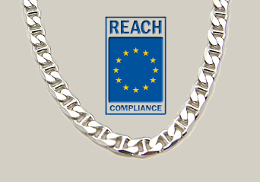Meeting in Brussels with the European Commission on June 28, CIBJO EU Committee pointed to difficulties being encountered in implementing the European Union’s revised legal standard for testing articles for compliance with nickel release limits.
The new legal standard part of the EU’s REACH Regulations, which concern the registration, evaluation, authorisation and restriction of chemicals. The section referred to is EN 1811:1998, which is the revised standard for testing articles for compliance with nickel release limits. It became effective in the EU from March 31, 2013, and replaced the earlier standard from 1998.
EN 1811:2011 is applicable to articles intended to come into prolonged and direct contact with the skin. It therefore applies to most articles of jewellery and watches. Ear-rings and other types of jewellery used in body piercings have even lower permitted release limits than articles worn against the skin.
In the new standard the adjustment factor of 0.1 has been replaced by an “uncertainty of measurement,” which, as explained in a document released by the Laboratory by the Birmingham Assay Office in the United Kingdom, will normally be taken as 46 percent. In effect this moves the compliance level for an article from 5.00 micrograms per centimetre squared per week to less than or equal to 0.28 for watches, bracelets, necklaces and rings, while for ear-ring and body piercing jewellery inserted in the skin, the compliance level limit drops from less than 2.00 to less than or equal to 0.11 micrograms per centimetre squared per week.
There is also a “no decision” category where the item is deemed to have neither passed nor failed. Articles releasing between 0.28 and 0.88 micrograms must be considered as “undecided” because they do not fail the requirements of the regulations, and the same for piercings between 0.11 and 0.35.
A consequence of the new standards is that some alloys which until now have been considered nickel compliant will no longer be so.
The CIBJO EU Committee notified their EC counterparts that CIBJO national members in the European Union are urging their respective national standards bodies to seek a nickel release compliance level of 0.88 micrograms centimetres squared per week for watches, bracelets, necklaces and rings, and 0.35 micrograms squared per week for ear-ring and body piercing jewellery inserted in the skin.
The CIBJO EU Committee also called on the EU to regard products already in the supply chain prior to March 31, 2013, and which conform to EN 1811:1998, as being nickel release compliant.

